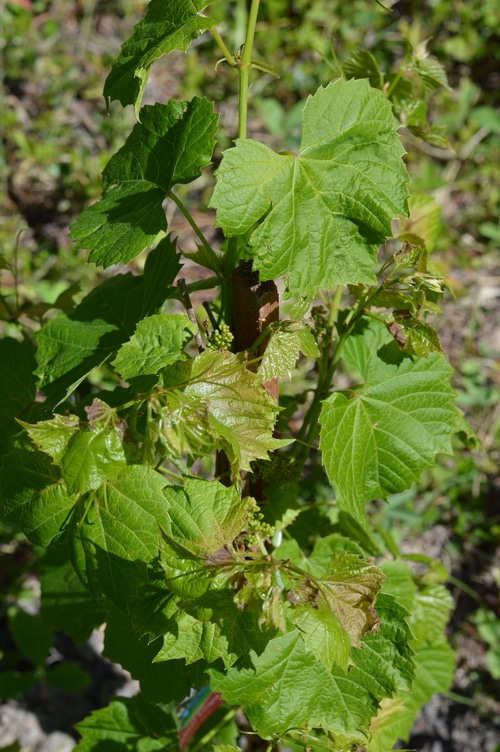How to Ferment Grape Leaves and Eat Them in Winter
Are you missing out on this nutritious garden green?
While your grapevines are at their active growth stage, in midsummer, harvest a few dozen leaves and preserve them for later use. Fermented grape leaves are pliable and flavourful, perfect for wrapping up fillings. If you’ve never tried this often overlooked vegetable, you’ll want to do it this year.
Fermented grape leaves, when used raw provide beneficial microbes. Grape leaves are a good source of Vitamins A, B6, C, E, K, niacin riboflavin, and folate as well as Calcium, Magnesium, Copper, Manganese, and Iron, and a very good source of Dietary Fiber. They are also high in β-Glucans (beta-glucans), which are naturally occurring polysaccharides. as well as resveratrol, an antioxidant. Both of these stimulate the immune system and have been shown to fight cancer.

Grape leaves are a staple of Mediterranean cuisine, served filled, in the same way, that cabbage rolls are filled. Grape leaves, however, have a milder flavour. Both savoury fillings and sweet fillings are appropriate to wrap in grape leaves. Try fresh figs with goat cheese, lamb and rice, or mushrooms and couscous. Rolled grape leaves can be served cold on an appetizer tray or warmed for a main course. Note that heated grape leaves will lose their healthy probiotics but retain their other nutritional values.

You’ll want to pick grape leaves from the ends of the actively growing vines. Pick tender leaves that are still bright green in colour. The leaves will darken during fermentation. Aim for larger leaves about the size of your palm. Smaller leaves make smaller rolls.

Fermented Grape Leaves
Yield: 1 pint
Ingredients:
- 30 large, organic grape leaves
- 2 cups filtered water
- 1 tablespoon Himalayan salt
- 2 tablespoons starter from a previous ferment.

Directions:
- Harvest fresh grape leaves. Prepare them for fermenting on the same day that you harvest them. Wash the leaves and remove their stems by snipping off with scissors, close to the base of the leaf.
- Sanitize a wide mouth pint jar and the FermenTools glass weight, lid, seal, and fermentation lock, or another propriety brand fermentation system. I use the FermenTools kit.
- Stack the leaves backside down, with 8 to 10 leaves in each stack. Roll each stack, with the back of the leaves on the outside. Place each roll of grape leaves inside the sanitized Mason jar. Repeat until your jar is full.

- Make the brine by dissolving 1 tablespoon of Himalayan salt into the water and adding starter culture from a previous successful fermentation.
- Pour the brine into the jar, making sure that all the rolls of leaves are completely covered. Use a knife to dislodge any air bubbles in the jar. Ensure that the brine fills each bundle of leaves by pressing the side of a blunt knife into the side of each bundle to release the trapped air.
- Add a fermentation glass weight to the top of the jar, ensuring that the brine comes over the top of the weight. Cap the jar with the fermentation lock.
- Allow the leaves to ferment at room temperature for 4-7 days. If your home is warm it will be done sooner. If your home is cool it may take a day or two longer. Fermentation is done when the grape leaves drop inside the jar and are no longer floating, and any active bubbling inside the jar has stopped.
- Store the fermented vine leaves in the fridge or in a cool dry place.
How to use fermented vine leaves:

Dolmades are traditionally made with fermented grape leaves and rice with other fillings added like ground lamb, raisins, mushrooms, or beans. See my “Lamb Dolmandes” recipe on the Mushroom Canada blog.
Try this traditional Lebanese stuffed grape leaves recipe with chicken from Studio Botanica
You can also try cabbage roll fillings with grape leaves, but they will be smaller than the cabbage rolls you are used to.



Do you know if sweet potato leaves can be fermented in this way?
How long can you store them before using?
Who do you store the fermented leaves?
I store them in a wide mouth canning jar in my fridge. Make sure they are completely covered in brine and you won’t have any problems.
I have wild grapes growing in places in our yard and plan to pick after frost. Can I go ahead and ferment the leaves now? Does it matter if they’re wild?
Yes you can ferment them now. Don’t wait till frost.
What time of year would be the best time to harvest the leaves for fermentation?
When they are actively growing.
And what if you don’t have a previous fermentation to get cultures from?
You can just use salt. It takes a bit longer for the fermentation to get going without the culture. But it isn’t essential.